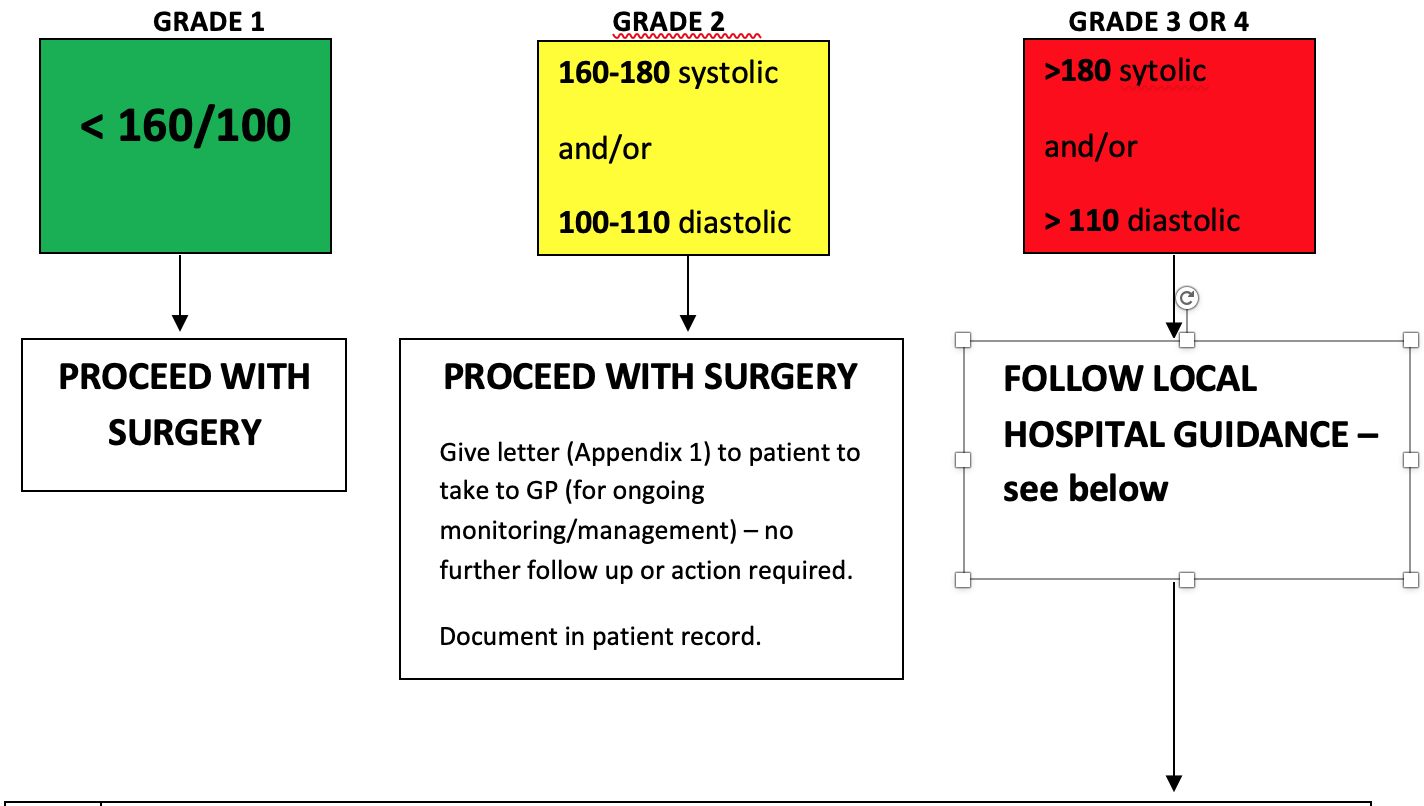- Check BP at PAC.
- If elevated above 160 systolic or 100 diastolic, repeat the measurement.
- If still elevated, repeat again.
- Use the lowest reading, and refer to guidance below.


Pre-operative assessment of patients with Hypertension for elective surgery
Appendix 1 – Letter to be given to patient to take to GP, confirming patient had Grade 2 hypertension at PAC.
Dear Doctor
The above patient was found to have an elevated blood pressure at the preoperative clinic today – the measurement was ________mmHg.Although this level of hypertension does not require postponement of surgery, we have advised the patient to attend their GP practice for further assessment.
Thank you for your cooperation.
Yours sincerely
The report will typically be sent back to PAC within 7-10 days.
The `average awake reading` should be used.
Patients with Grade 3 hypertension (systolic >180 and/or diastolic >110) should have non-urgent surgery postponed, and should be referred back to GP for optimisation (minimum of 4-6 weeks treatment).
Patients with Grade 1 (140-159, and/or 90-99), Grade 2 (160-179, and/or 100-109), or white-coat hypertension should proceed with surgery.
Two copies of the report are provided by OPD 2 – one should be place in the patient`s notes and the other sent to the GP along with a dictated letter, templates for which are available – see appendix 4.A copy of this letter should be made available on TRAK.
Result should be communicated to patient.
Appendix 3 – Suggested template letter to GP for patients with Grade 3 hypertension at PAC who are unable to have 24-hour monitoring and require postponement (taken and modified from AAGBI/BHS BP guidelines 2016).
Dear Doctor
Unfortunately, the procedure for the above patient has been postponed because their blood pressure was found to be above the acceptable level for elective surgery.The AAGBI/BHS guidelines suggest a blood pressure level higher than 180/110 is unsuitable for elective procedures.
In this situation we usually try and arrange 24-hour ambulatory monitoring, but on this occasion this was not possible.We have asked the patient to make an appointment at their surgery for further assessment.We would be grateful if you could verify that this is the true blood pressure level and not a white coat effect and treat appropriately if the patient has hypertension – we would suggest a minimum of 4-6 weeks treatment.
We will be pleased to accept the patient back for surgery if their clinical blood pressure is below 160/100.Please get back in touch in due course so we can reschedule this procedure.
Many thanks for your help with this matter.
GRADE 1 TEMPLATE
Dear Dr
Your patient is scheduled to have orthopaedic surgery and was found to have an elevated blood pressure at the pre-operative assessment clinic.A 24-hour ambulatory blood pressure assessment has since been performed.The average day-time systolic and diastolic pressures were___and ___mmHg respectively.This represents grade 1hypertension.Although this level of hypertension does not require postponement of surgery it will require monitoring and treatment.I will leave this issue in your hands.
I enclose a copy of the report.
Yours sincerely
GRADE 2 TEMPLATE
Dear Dr
Your patient is scheduled to have orthopaedic surgery and was found to have an elevated blood pressure at the pre-operative assessment clinic.A 24-hour ambulatory blood pressure assessment has since been performed.The average day-time systolic and diastolic pressures were ___ and ___ mmHg respectively.This represents grade 2hypertension.Although this level of hypertension does not require postponement of surgery it will require monitoring and treatment.I will leave this issue in your hands.
I enclose a copy of the report.
Yours sincerely
NORMAL BP TEMPLATE
Dear Dr
Your patient is scheduled to have orthopaedic surgery and was found to have an elevated blood pressure at the preoperative assessment clinic.A 24 hour ambulatory blood pressure assessment has since been performed.The average day-time systolic and diastolic pressures were ___ and ___ mmHg respectively.This represents adequate BP control and no action is necessary.
I enclose a copy of the report.
Yours sincerely
GRADE | SYSTOLIC (mmHg) | DIASTOLIC (mmHg) |
Normal | Less than 140 | Less than 90 |
1 | 140-159 | 90-99 |
2 | 160-179 | 100-109 |
3 | 180-199 | 110-119 |
4 | 200+ | 120+ |